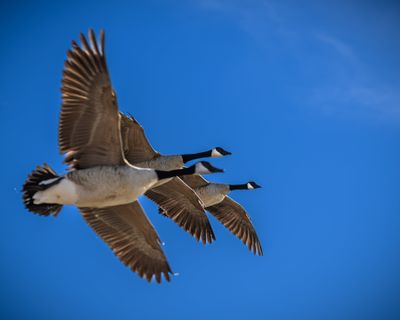Ask Dr. Universe: Birds migrate to find food, nesting spots

Dr. Universe: Why do birds migrate? – Lebron, 9, Virginia
Dear Lebron,
One of my favorite sights is when geese fly south in a “V” formation. I think it’s amazing to see birds fly together like that.
I talked about why birds migrate with my friend Heather Watts. She’s a biologist at Washington State University. She studies important animal behaviors like migration.
She told me that migration is a movement animals make that’s outside their normal day-to-day pattern. It’s usually a temporary movement. They leave for a little while and then come back.
Lots of animals migrate, but we usually think of birds doing it. The big reason birds migrate is to find things they need like food and places to nest.
“We think that, in most cases, birds are migrating to make use of resources – and that’s usually food that’s available only at some times of year,” Watts said.
Let’s say there’s a yummy food that’s plentiful here in Washington state in the summer. Some birds move here and spend the warm months snarfing it up. But Washington winters can be cold and harsh. Those food resources will go away. So, those birds might move south. Closer to the equator, they’ll enjoy a warmer winter with lots of tasty food.
Scientists aren’t sure exactly how birds that migrate know to do it. Some parts seem to be hard-wired. That means they’re born with the urge to do it. Other parts seem to be learned from older birds or through experience.
Watts told me that scientists think some birds have something called a “clock and compass.” That’s a hard-wired genetic program that sends birds in a certain direction for a certain amount of time.
Once they make that journey, they learn landmarks. They might also pick up on things that humans can’t see or feel like magnetic cues from the Earth. Some birds learn where to go from following older birds the first time they migrate.
It turns out migrating is a lot more work than I expected. Birds have to tank up on food to fuel the journey. Their flight muscles get bigger and stronger. Some of their internal organs – like their stomachs – shrink.
But all of that is just one way to migrate. Watts told me that different kinds of birds migrate in different ways. There are those that migrate together in a group like my geese. Others migrate on their own. Some travel alone but take breaks from flying with other birds.
Then there are birds that do a partial migration. A portion of them migrate while others stay where they are as resident birds. There’s even variation in how partial migration works, depending on the birds.
“In some species, it’s hardwired, so you’re either a migrant or resident,” Watts said. “In other species, birds can switch throughout their lifetime.”
The birds Watts studies do nomadic migration. Their migratory movements look more like wandering as they seek out food resources that aren’t as predictable. To study those birds, scientists bring them back to their labs because it would be really hard to guess where to find them when they’re wandering.
I guess when it comes to adapting their behavior to survive, birds aren’t just good, they’re mi-great.
Sincerely,
Dr. Universe
Adults can help kids submit a question at askdruniverse.wsu.edu/ask.